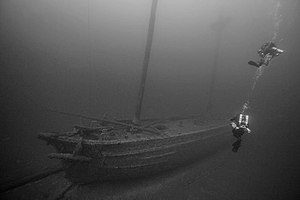 Kyle Spangler wreck Kyle Spangler wreck
| |
| History | |
|---|---|
| Name | Kyle Spangler |
| Operator | B. L. Spangler Co. |
| Builder | William Jones |
| Launched | May 12, 1856 |
| Completed | 1856 |
| Fate | Sunk in collision November 5, 1860 |
| General characteristics | |
| Tonnage | 349 tons |
| Length | 130 feet |
| Beam | 26 feet |
| Depth | 11 feet |
| Decks | 1 |
| KYLE SPANGLER (schooner) Shipwreck Site | |
| U.S. National Register of Historic Places | |
  | |
| Location | Lake Huron, 4 miles (6.4 km) northeast of Presque Isle |
| Coordinates | 45°23′1″N 83°26′7″W / 45.38361°N 83.43528°W / 45.38361; -83.43528 |
| Built by | William Jones |
| Architectural style | shipwreck site |
| NRHP reference No. | 14001098 |
| Added to NRHP | August 22, 2016 |
The Kyle Spangler was a wooden schooner; its 1860 wreck site in Lake Huron was listed on the National Register of Historic Places in 2016.
History
Basil L. Spangler, born in 1817, was a dry-goods merchant from Cleveland who ran his own form, B. L. Spangler and Company. In 1856, Spangler commissioned William Jones, a shipbuilder from Black River Ohio (now Lorain), to construct a schooner. The schooner was named Kyle Spangler, after Spangler's son, born in 1851. The ship was launched on May 12, 1856, and departed Cleveland with a cargo of coal two days later.
The Spangler was a traditional mid-nineteenth century cargo schooner that hauled various cargoes on the freshwater Great Lakes, and on to saltwater ports along the east coast. including iron ore, salt, coal, corn and wheat.
Like many schooners of the time, the Spangler endured a series of shipping incidents. In May 1856 she tore a hole in her bottom on a reef in Lake Huron. In 1857, she spring a leak in Lake Michigan, and was run aground just south of Sleeping Bear Bay before she sank. It was almost a year before she was refloated. The ship was dismasted in 1858, and later that same year collided with another schooner in the Straits of Mackinac. In 1859, the Spangler sailed into the Atlantic Ocean with a load of lumber, and returned the following spring.
On November 5, 1860, while upbound on Lake Huron on a dark night with a load of corn, the Spangler collided with the downbound schooner Racine, crushing the Spangler's bow and sinking her. All crewmen were rescued safely.
The wreck
The wreck was discovered in 2003 by diver Stan Stock while searching for the semi-whaleback freighter Choctaw. Over the next few years, Stock and a team from the National Oceanic and Atmospheric Administration’s Thunder Bay National Marine Sanctuary documented the wreck. In 2008, it was decided to release the location of the wreck to the general public, and the location has become a popular scuba diving attraction.
The Kyle Spangler lies upright in 185 feet (56 meters) of water, and much of the wreck is undamaged save the bow. The cold, fresh water of Lake Huron has kept the wreck well preserved, and the ship looks much as she did during the 1850s, with both masts (including crosstrees) intact and upright. The wreck lists twenty degrees to the starboard side.
The ship's wheel, steering gear and rudder are intact, as are two bilge pumps and the main winch and capstan. The interior cabin structure is relatively intact, but the woodwork has collapsed, making small items difficult to discern. The cargo hold hatch covers are displaced, giving easy access to the hold.
References
- ^ SPANGLER, KYLE; 1856; Schooner, Great Lakes Maritime Database
- ^ National Register of Historic Places Program: KYLE SPANGLER (schooner) Shipwreck Site, National Park Service, December 16, 2016
- ^ Russ Green (January 11, 2016), National Register of Historic Places Registration Form : Schooner KYLE SPANGLER Shipwreck Site (PDF)
- ^ Kyle Spangler, Thunder Bay National Marine Sanctuary
- ^ Kyle Spangler Wreck, Thunder Bay Wrecks
- "Two Historic Shipwrecks Discovered in Thunder Bay National Marine Sanctuary". Thunder Bay National Marine Sanctuary. Archived from the original on March 5, 2018. Retrieved March 4, 2018.
{{cite web}}: CS1 maint: bot: original URL status unknown (link)
Images
| Shipwrecks and maritime incidents in 1860 | |
|---|---|
| Shipwrecks |
|
| Other incidents |
|
| 1859 | |
| U.S. National Register of Historic Places | |
|---|---|
| Topics | |
| Lists by state |
|
| Lists by insular areas | |
| Lists by associated state | |
| Other areas | |
| Related | |
| National Register of Historic Places shipwrecks in Lake Huron | |
|---|---|
| See also: List of Great Lakes shipwrecks on the National Register of Historic Places |
- Shipwrecks on the National Register of Historic Places in Michigan
- Great Lakes freighters
- Maritime incidents in November 1860
- Ships sunk in collisions
- Shipwrecks of Lake Huron
- 1856 ships
- Ships built in Lorain, Ohio
- National Register of Historic Places in Presque Isle County, Michigan
- Wreck diving sites in the United States
- Thunder Bay National Marine Sanctuary
- 2003 archaeological discoveries


